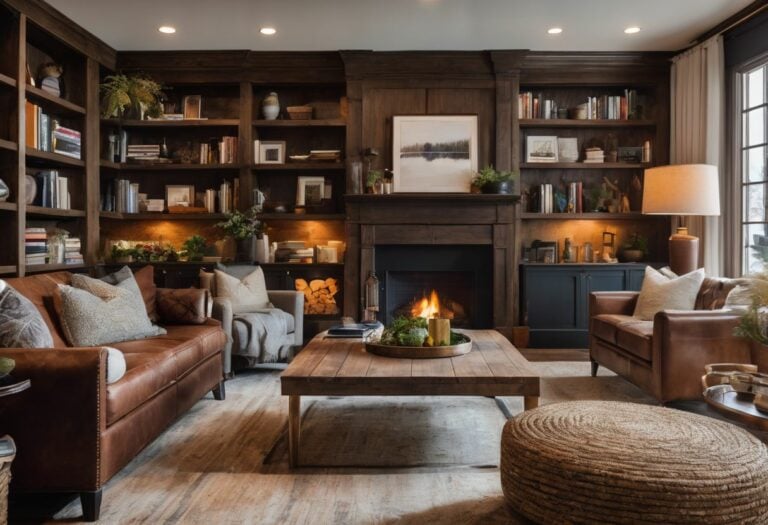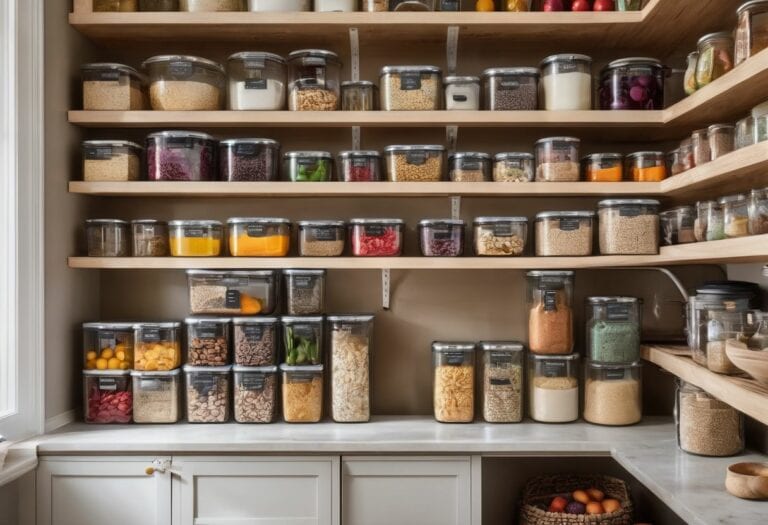How Do You Restore a Wooden Dining Table? A Step-by-Step Guide
Understand this – your beloved wooden dining table that has lost its shine or exhibits the battle scars of years of wear and tear, I’ve walked in those shoes too. It was a daunting task to spruce it up until not very long ago.
After an exhaustive search for answers, allow me to share with you a comprehensive step-by-step guide that simplifies restoring your treasured furniture piece into straightforward steps.
Stay with me here as we unravel together – the magic formula to breathe new life into your weathered furniture!
Key Takeaways
- Determine the type of wood your dining table is made from before starting any restoration work.
- Assess the existing damage on your table to understand how much work needs to be done.
- Consider the desired result you want for your table’s appearance before starting the restoration process.
- Gather supplies such as sandpaper, paint or stain, a stripping solution, and protective equipment like gloves and goggles.
- Clean the table by removing debris and using a wood cleaner to get rid of dirt and grime.
- Sand any rough spots on the table’s surface to create a smooth base for refinishing.
- Choose the right stripping solution and apply it evenly across the surface to remove the old finish from your wooden dining table.
- Use sandpaper with a coarse grit to start sanding your table, gradually progressing to finer – grit papers for a smoother finish.
- Consider whether you want to paint or stain your table based on personal preference and desired aesthetic outcome.
- Apply multiple thin coats of paint or stain, allowing each coat to dry before adding another layer.
- Protect your finished table with a clear sealant or varnish for long – lasting beauty and durability.
How Do You Restore a Wooden Dining Table?

To restore a wooden dining table, start by determining the type of wood it is made from, assessing any existing damage, and considering the desired result.
Determine the type of wood
First, you need to know the type of wood your dining table is made from. Many tables are made from woods like oak, birch, ash, beech, teak or acacia. Some others could be rosewood, ebony, walnut or cedar as well.
It is key to find out what kind of wood you have before starting any work. Each kind of wood takes paint and stain in different ways. Also, some woods are harder than others and might need more sanding or a stronger stripping solution.
Assess any existing damage
Let’s start by looking at the wooden table closely. It is important to inspect it well for any marks or scratches. This first step helps you know how much work you have to do.
Next, does your table have a worn-out look? Don’t worry! That only means it needs some extra care and love. During this process, always keep an eye out for new damages that might show up while cleaning the table.
It’s all part of bringing back life into an old favorite piece of furniture in your home.
Consider the desired result
Think about how you want your table to look at the end. Maybe you wish to keep its old charm or give it a brand new style. A clear vision helps make sure you pick the right stuff for restoring later on.
Some might love a rich dark stain, while others prefer a natural wood color. It all depends on your taste and what fits best in your home’s decor. Be sure of this before you start working on the table.
Do take time to research if your tabletop is wood or veneer as this will impact the final result too!
1. Gathering Supplies

To gather all the necessary supplies, you will need sandpaper, paint or stain, a stripping solution, and protective equipment such as gloves and goggles.
Sandpaper
To restore a wooden dining table, sandpaper is an essential tool. Sandpaper helps to smooth out rough spots and remove the old finish or stain from the table surface. When sanding the table, it’s important to start with a coarse-grit sandpaper and gradually progress to finer-grit papers for a smoother finish.
Additionally, remember to always sand in the direction of the wood grain to avoid damaging the surface. By using sandpaper correctly during the restoration process, you can achieve a beautiful result that brings your wooden dining table back to its former glory.
Paint or stain
When it comes to restoring a wooden dining table, you have the option to either paint or stain it. Painting involves applying a layer of paint to the surface, while staining allows the natural grain of the wood to show through with a tinted finish.
If you decide to paint your table, choose a high-quality paint that is specifically formulated for wood furniture. Apply several thin coats using a brush or roller, allowing each coat to dry before adding another.
This will ensure an even and smooth finish.
On the other hand, if you prefer to stain your table, start by sanding down the surface to remove any old finish or rough spots. Once sanded, wipe away any dust and apply the stain using a brush or cloth in long strokes following the direction of the grain.
Allow each coat of stain to fully dry before applying additional coats for deeper color.
Stripping solution
To restore a wooden dining table, using a stripping solution is an important step. One recommended product is KleanStrip. This solution helps to loosen and remove the old finish from the table’s surface.
To apply it, I use a brush and carefully cover the entire table with the stripping solution. This allows the solution to work its magic in breaking down and loosening any residue or leftover finish on the wood.
After applying the stripping solution, I follow up with sanding to ensure a smooth surface for refinishing. By choosing the appropriate stripping agent and applying it correctly, I am able to effectively prepare my wooden dining table for further restoration steps.
Protective equipment
When working on restoring a wooden dining table, it’s important to prioritize safety by using the right protective equipment. Wearing safety goggles, a respirator mask, and protective gloves can help protect you from potential health risks and injuries.
Woodworking machinery can produce harmful dust particles that can be inhaled or cause irritation to your skin and eyes. By wearing safety gear, you can minimize these risks and ensure a safer woodworking experience.
Remembering to take proper precautions with protective equipment is crucial for maintaining your well-being while restoring your wooden dining table.
2. Cleaning the Table
To clean the table, remove any debris and use a wood cleaner to effectively get rid of dirt and grime. Then, sand any rough spots on the surface to create a smooth base for refinishing.
Remove any debris
Cleaning the table is an important first step in restoring a wooden dining table. Before you start, make sure to clear away any debris on the surface. This can include things like dust, crumbs, or any loose particles that may be stuck to the table.
You can do this by sweeping or using a soft brush to gently remove the debris from the surface. It’s important to get rid of any dirt and grime before moving on to the next steps of restoration.
Once you’ve cleared away the debris, you can use a wood cleaner or degreaser product to sanitize and cleanse the table further. This will help remove any stubborn stains or sticky residue that may still be present on the surface.
Make sure to follow the instructions on your chosen cleaner and use a soft cloth or sponge for application.
Use a wood cleaner
To clean your wooden dining table, I recommend using a wood cleaner. This will help remove any dirt, grime, and food stains that may be present on the surface. Start by wiping down the table with a dry brush or cleaning scrub brush to get rid of any loose debris or crumbs.
If there’s sticky residue, you can scrape it off using a dish or credit card. Then, take a microfiber cloth and apply the wood cleaner according to the instructions on the bottle. Gently rub the cleaner onto the surface of your table, making sure to reach all areas including crevices and corners.
Finally, wipe away any excess cleaner with a clean cloth and let your table air dry completely before proceeding to other restoration steps. Using a wood cleaner regularly is also a great way to prevent future damage and maintain the finish of your dining table.
Sand any rough spots
To restore a wooden dining table, it’s important to sand any rough spots. Sanding helps smooth out imperfections and preserve the integrity of the furniture. It also prevents unintentional sanding marks and damage to the wood.
When sanding, make sure to go in the direction of the wood grain to protect the wood fibers. This will help maintain the natural look of your table. If your table has MDF edges, using a scuff sanding technique with a sanding sponge is recommended for proper paint adhesion.
So take your time and ensure you give attention to detail while sanding any rough spots on your wooden dining table during the restoration process.
3. Stripping the Old Finish
To strip the old finish from your wooden dining table, choose a suitable stripping solution and apply it evenly across the surface using a chip brush. Allow the solution to penetrate for the recommended amount of time, then use a scraper or steel wool to remove the old finish.
Choosing the right stripping solution
When restoring a wooden dining table, it’s crucial to choose the right stripping solution. The stripping solution is what helps remove the old finish from the wood surface. It’s important to select a solution that is effective in loosening the old coating and softening any residue left behind by previous stripping products.
One recommended option is KleanStrip Stripper, which has been found to be effective in enhancing the wood grain and preparing the surface for refinishing. By selecting the appropriate remover and using proper application techniques, you can ensure a successful restoration process for your wooden dining table.
Applying the solution
To restore a wooden dining table, one important step is applying the stripping solution to remove the old finish. This can be done using a liquid stripper applied with a brush. After the solution is applied, I use a putty knife or scraper to gently remove the first layer of finish along the grain of the wood.
If my goal is to completely remove the old finish or paint, I prefer using chemical strippers. It’s important to follow instructions carefully and wear protective equipment when working with these chemicals.
By applying the stripping solution correctly, I can effectively prepare my wooden dining table for further restoration steps.
Removing the old finish
To restore a wooden dining table, the first step is removing the old finish. This can be done using medium coarse steel wool on the rounded edges of the table. For the rest of the surface, chemical strippers are recommended to completely remove any old finish or paint from the wood furniture.
By stripping away the previous coating, you create a clean slate for refinishing and bring out the natural beauty of your dining table.
4. Sanding the Table
Now it’s time to smooth out any imperfections and create a fresh canvas for your finish. Learn the proper sanding techniques to achieve a flawless surface. Read more to restore your wooden dining table to its former glory.
Start with a coarse grit sandpaper
To restore your wooden dining table, the first step is to start with a coarse grit sandpaper. This helps to remove the original top coat from the table. The roughest sandpaper to use is 60-grit, which is perfect for getting rid of tough paint or stain on the surface of your table.
It’s also great for rounding corners and shaping the wood. By starting with a coarse grit sandpaper, you can prepare your table for the next steps in the restoration process.
Remember:
– Starting with a coarse grit sandpaper helps remove the original top coat.
Progress to finer grit
When sanding a wooden dining table during the restoration process, it’s important to progress to finer grit sandpaper. This helps to achieve a smooth and polished surface. The recommended grit progression typically involves starting with coarse sandpaper, such as 60-grit, then moving on to medium grit like 120-grit, and finally finishing with fine sandpaper around 360-grit.
It’s also necessary to lightly sand the table between coats of paint or stain using a finer grit like 220 or fine steel wool. Remember that you don’t need to use every available grit when sanding, and you can jump from coarser to finer grits if needed.
So be sure to choose the right sandpaper for your refinishing project and progress gradually towards a beautifully restored wooden dining table.
Smooth out scratches and dents
To smooth out scratches and dents on your wooden dining table, you’ll need to do some sanding. Start by using a coarse grit sandpaper to gently rub the surface of the table in the direction of the wood grain.
This will help to remove any rough spots or raised areas caused by scratches. As you progress, switch to finer grit sandpaper, like 180-grit, to further smooth out the surface.
If there are deeper scratches that can’t be fixed with sanding alone, you can use a furniture repair marker or wood filler specifically designed for repairing wood. Apply it carefully to fill in the scratch and let it dry completely before sanding again.
5. Adding Color
To add color to your wooden dining table, you have the option of either painting or staining it.
Options for painting or staining
When it comes to painting or staining your wooden dining table, you have a few options. If you want to change the color of the wood completely, stripping off the existing finish and applying a new stain is a reliable method.
You can choose from various shades of stain to achieve your desired look.
If painting is more your style, make sure to sand the table first to create a smooth surface for the paint to adhere to. Then, apply a coat or two of primer before painting with your chosen color.
Finally, seal the table with a protective topcoat to keep it looking great for years to come.
Tips for layering stains
When layering stains on your wooden dining table, there are a few tips to keep in mind. First, apply a pre-stain conditioner before staining to ensure an even color distribution. This helps the wood absorb the stain more evenly and prevents blotchiness.
Second, sand the table between coats and apply multiple coats of stain for a richer color. The more layers you add, the deeper and more vibrant the final color will be. Finally, make sure to wipe off any excess stain after allowing it to sit for a few minutes.
This will prevent a sticky residue and give you the desired color for your table.
Techniques for achieving desired color
When it comes to achieving the desired color for your wooden dining table, there are a few techniques you can try. One option is painting the table with a suitable paint color that matches your aesthetic.
Another technique is staining the wood to enhance its natural beauty and bring out the grain patterns. If you want to change the existing color of the wood, you will need to completely remove any old finish through sanding or using a chemical stripper before applying your desired stain or paint.
It’s important to consider multiple coats and layering stains if you want a deeper, richer color. Remember to always follow the manufacturer’s instructions and take proper precautions when working with paints, stains, or strippers.
6. Sealing the Table
To seal the table, choose a suitable sealant and apply it in a smooth, even layer using a chip brush.
Choosing the right sealant
When it comes to sealing your wooden dining table, it’s important to choose the right sealant. The sealant helps protect your table from dust, liquids, and other substances that can cause damage.
Look for a surface sealer that offers scratch resistance and is water repellent. This will help keep your table looking good for a long time. Additionally, if you have painted or stained your table, adding a clear coat of sealant can improve its longevity.
Just make sure to allow sufficient dry time before applying the sealant if using an oil-based finish. Remember, choosing the right sealant is an important step in maintaining and protecting your wooden dining table.
Applying the sealant
Now it’s time to apply the sealant to your wooden dining table. Choosing the right sealant is important for protecting and enhancing the wood’s natural beauty. Make sure that you’ve allowed the stain to dry for at least eight hours before applying the sealant.
This will ensure that it bonds properly with the wood. When applying the sealant, be generous in your application, making sure to cover every part of the surface. Avoid applying a second coat, as this can make sanding difficult later on.
Once you’ve applied the sealant, allow it to dry completely before buffing it for a smooth finish. Applying a generous coat of sealant is especially important if your table has cracks or holes.
Buffing for a smooth finish
Once you have applied the sealant to your wooden dining table, buffing is key to achieving a smooth finish. Buffing helps to remove any imperfections and gives your table a polished look.
To do this, you will need a soft cloth or a buffing pad attached to an electric drill. Simply apply gentle pressure as you move the cloth or pad in circular motions across the surface of the table.
This will help to spread and evenly distribute the sealant while also smoothing out any rough areas. Take your time and continue buffing until you are satisfied with the result. Remember, buffing is an important final step in protecting and enhancing the beauty of your restored wooden dining table.
Other Tips and Tricks
In addition to the step-by-step process, I’ll share some valuable tips and tricks that will help you achieve professional results. So keep reading to discover expert techniques for refinishing your wooden dining table!
Layering finishes
When restoring a wooden dining table, layering finishes can be a helpful tip. This involves applying a clear coat over the stained or painted surface. It’s important to choose the right sealant for this step, such as polyurethane or polycrylic.
Layering finishes not only enhances the appearance of the table but also provides protection against wear and tear. By adding an extra layer of coating, you can preserve the beauty of your wooden dining table for years to come.
Gel stain can also be used as an alternative method for layering finishes without stripping off the original top coat.
Using a heat gun for stubborn finishes
During the restoration process, using a heat gun can be really helpful to remove stubborn finishes from your wooden dining table. Heat guns work by softening varnishes or layers of paint, making it easier to scrape off the old finish.
What’s great about heat guns is that they minimize dust compared to other methods like sanding or using chemical strippers. So, if you’re dealing with a tough finish on your table, a heat gun can be a handy tool in your DIY furniture refurbishment arsenal.
How to refinish a veneer top
To refinish a veneer top, start by removing the existing finish and lightly sanding the surface. This may be necessary if the veneer is flaking or damaged. Then, repair any chips or cracks in the veneer using wood putty and a putty knife.
Smooth out the repaired areas with sandpaper. Next, choose your desired finish – you can either leave it as is or paint/stain it to achieve the desired look. Apply multiple layers of paint or stain for better coverage and depth of color.
Finally, seal the veneer with an appropriate sealant to protect it from damage and give it a smooth finish. Remember to follow all safety precautions and use protective equipment throughout the refinishing process.
Conclusion
Restoring a wooden dining table may seem daunting, but with the right steps and supplies, it can be done. By stripping the old finish, cleaning, sanding, and adding paint or stain, you can transform your table into a beautiful piece once again.
Don’t forget to choose the right sealant to protect your hard work. With this step-by-step guide, you’ll have a restored wooden dining table in no time!
FAQs
1. Can I restore a wooden dining table myself?
Yes, you can restore a wooden dining table yourself by following a step-by-step guide and using the right tools and materials.
2. What tools do I need to restore a wooden dining table?
You will need sandpaper, wood stain or paint, varnish or sealant, brushes, rags, and possibly a sander depending on the condition of the table.
3. How long does it take to restore a wooden dining table?
The time it takes to restore a wooden dining table depends on factors such as the size of the table, its current condition, and your level of experience. It can range from several hours to multiple days.
4. Should I remove old finish before restoring my wooden dining table?
Yes, it is recommended to remove the old finish from your wooden dining table before starting the restoration process. This allows for better adhesion of new finishes and ensures a smoother final result.
5. Can I use any type of stain or paint for my wooden dining table restoration?
No, it’s important to choose stains or paints specifically designed for wood surfaces when restoring your dining table. These products are formulated to provide durability and enhance the natural beauty of wood.







